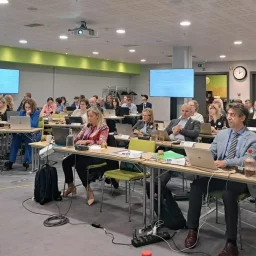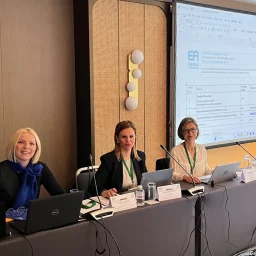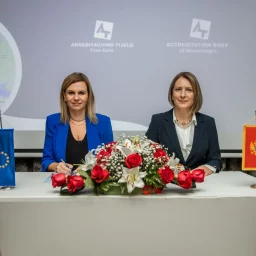The European co-operation for Accreditation (EA) is recognized by the European Commission to operate the peer evaluation system according Regulation (EC) No 765/2008 on accreditation.
Peer evaluation shall ascertain whether the National Accreditation Bodies (NABs) meet the requirements laid down in Regulation (EC) No 765/2008, relevant harmonised standards and mandatory EA and international documents.
National authorities shall recognise the equivalence of the services delivered by those NABs which have successfully undergone EA peer evaluation, and thereby accept the accreditation certificates of those bodies and the certificates and reports issued by the accredited Conformity Assessment Bodies.
To perform these peer evaluations (PE), EA mandates peer evaluators, highly qualified and experienced NAB staff members.
One of these EA peer evaluators is Leopoldo Cortez, President of the Board of Directors for the Portuguese National Accreditation Body, IPAC.
Leopoldo Cortez, you have been a peer evaluator of EA for 25 years. Would you say that the Peer Evaluation work/EA’s approach to PE have changed over the years?
My first peer-evaluation was in 1995. At that time, we were only 5 persons for the scopes of calibration and testing, and the former European association of testing Accreditation Bodies (WELAC) had just merged with the association of calibration Accreditation Bodies (WECC) to form EAL (European accreditation for laboratories) – later to merge with EAC (certification) and become EA in the end.
What was different back then? Essentially the requirements to be met by the ABs, the communication (no e-mail, just letters and phones, and sometimes faxes) and a lot of paper to handle. The format of the peer-evaluation, however, was similar, with a week of work, for witnessing, reviewing files, and interviewing staff. The spirit of being a peer-evaluation, and not an assessment, was also the same.
But the methodology for performing a peer-evaluation had some differences: the committee managing the Multilateral Agreement (MLA) would only choose the Team Leader, and he/she would select and propose from the list of approved peer-evaluators the members of the team.
Moreover, since WECC/EAL were running interlaboratory comparisons for accredited calibration laboratories, the outcome of participation (or not) would also be discussed for the decision-making on the peer-evaluation.
How did the peer evaluation system adapt to the changes in the NABs over the past 20 years?
The biggest changes for me are the growth of MLA scopes and communication tools. Today is common to have 6-8 MLA scopes to peer-evaluate during the same week, so the number of peer-evaluators grew. It has also triggered change: we now focus more on understanding how the NAB gets access to competence and deploys it for its assessments and decision-making.
Sampling is more relevant nowadays, due to the variety of conformity assessment activities that NABs accredit, and the bigger number of accredited bodies, but we have now better tools to facilitate our work, since the management of information inside the NABs has improved considerably in most cases.
The communication boom made it possible, not only to decrease the delivery times, but also to react faster, and access any information almost instantaneously.
The peer-evaluation (PE) system had to adapt itself to these new realities, but also to the implementation of Regulation (CE) No. 765/2008. It is not just a private agreement between accreditation bodies, it’s a binding agreement between national accreditation bodies and authorities, with legal implications. So, the PE system became more ‘professional’ and consistent, and aware of the use of accreditation in the regulatory area, which became more targeted in the sampling.
In my view, it’s coming to a breaking point, since the PE teams are growing so much. It’s getting increasingly difficult to manage teams of 10 to 15 people as it occurs sometimes – and the frequency of an event every 4 years, that we’ve been using for the past 25 years. The peer-evaluation system could and should be improved.
How do you see your role as a Team Leader (TL) for EA?
Nowadays, the Team Leader is mainly the conductor or maestro of an orchestra, due to the increasing size of the PE teams – his/her leadership’s skills are more important than ever, he/she will have to obtain the best performance from all its PE Team’s members. Also, TL’s competence is required to have more focus on the NAB’s impartiality and structural elements, and the NAB’s competence approach. And being a TL in EA also means that I need to be aware of the implications of Regulation (CE) No. 765/2008 and the increased responsibilities that the Regulations bring to everyone in the EA PE system.
What is a typical workday like, as a TL?
It starts with a good planning, I usually develop an hourly schedule for each PE Team member, to make sure that everyone is coordinated and does not try to talk to the same person at the same time. This also assures that nothing is later forgotten due to the adrenaline boost during peer evaluations, when Team Members get excited when they are confronted with different ways to perform the NAB job or the language challenges appear or when misunderstandings occur. But the most challenging part of being a TL is before and especially after the peer evaluation, when daily jobs’ reality comes in, and time priorities need to be tuned to meet all commitments.
During the week of a peer evaluation, days are very long and tiring – it starts always very early, sometimes with travelling for witnessing in a distant city, and you have to think and communicate all day in a different language, so by the end of the day, when you have the chance to communicate with your family, it’s a relief. During witnessing days, you’re not taking the lead role, therefore it’s relaxing in that sense, but then you have to pay attention simultaneously to 2 persons (the NAB assessor and the Conformity Assessment Body person being interviewed), not only technically, but also to the non-verbal aspects, so in the end, the number of stimulus is still high.
During the days at the NAB’s office, I know that time goes by very quickly, so apart from doing my tasks, I regularly like to check my Team Members to see how they are with their planning and if anyone needs a word of advice. It’s also essential to make sure that the NAB’s persons are included in the communication round – being on the ‘other side’ of a PE creates a lot of anxiety that the TL needs to help manage, so that communication channels keep flowing freely.
An anecdote on a past peer evaluation you would like to share
I had very challenging peer evaluations, and each one brings memories – the most striking, although not the funniest, happened when I was the TL for a new signatory that was part of a governmental Department, and myself together with a Czech colleague, were doing the pre-evaluation.
So, it was a shorter visit, and we were on Friday morning discussing the conclusions of our visit – we had planned in the agenda the final meeting for 16 hours of that day, and by lunch time we were (still) discussing facts and findings. After lunch, we noticed that the AB Director was becoming more and more anxious and kept enquiring regularly about when the final meeting would be held; I had been responding that we still had work to do, but we would meet the timetable that we had sent.
It was about 14:30 when the AB Director knocked on the door once more and asked us for our plans – we gave the same reply, and added ‘maybe half an hour’ – the AB Director replied ‘Mr. Cortez, we are in the secure facilities of the Army and they will be closed after 15:00, so afterwards only the Defence Minister can allow us to leave, and he is on an international trip’. I looked to my teammate and I said ‘5 minutes’, he nodded nervously, the AB Director looked relieved and disappeared, and we had the most productive 5 minutes of a peer evaluation ever.
To find further information on the peer evaluation process
19 participants from 15 National Accreditation Bodies (NABs) participated in the training led by Hélène Mehay, Sergio Guzzi, and Ankica Barišić on 5-6 November 2025.
19 participants from 15 National Accreditation Bodies (NABs) participated in the training led by Hélène Mehay, Sergio Guzzi, and Ankica Barišić on 5-6 November 2025.
















